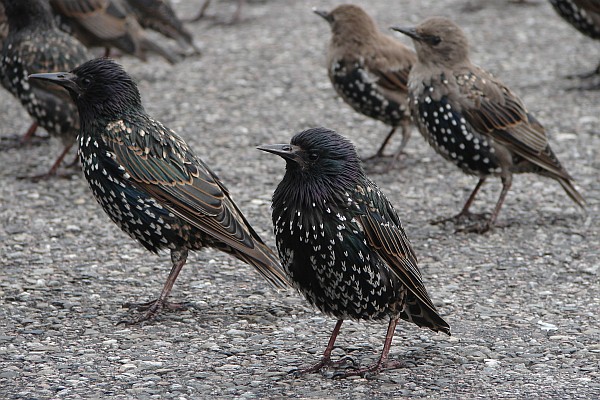The breeding season is over for the European starlings in my neighborhood.
The first sign that the adults had thrown in the towel came early this month when I noticed their beaks had completely changed from breeding season’s yellow back to black.
They’re also molting, replacing their dark, shiny feathers with new white-tipped ones that make them look speckled or “starry” (hence their starling name).
Right now they look like to the two birds in the foreground, above. Only two months ago they looked like this.
Not to be outdone, the juvenile starlings are molting, too. A newly fledged starling has drab brown feathers (click here to see) but they become starry by their first winter. Halfway through the molt sequence they look like the two motley birds in the background, above — drab heads, starry breasts.
Believe it or not, summer is half over.
The starlings, they are a’changing.
(photo by Daniel Plazanet on Wikimedia Commons. Click on the image to see the original)

Thanks Kate.. so that was a juvenile starling I saw in my yard. I was going crazy trying to figure it out and my field guide doesn’t show juveniles. perhaps I should get another one.. or do you have tips for novice bird watchers on how to know a bird is a juvie? Sorry if this is a dumb question.
Not a dumb question at all. The best way to identify a juvenile bird is to see it begging from an adult — which gives you a good reason to wait and watch birds. Other than that, a *very* good field guide is the only way to know.
Great info.! I hadn’t really thought about the beak change, although I have certainly witnessed it enough through the years.
Has anyone found anything that preys on starlings? I know they are not native to the U.S., but keep hoping that something will come along to limit the population, other than simply the food supply (which they feel free to pilfer from all the native birds, and pretty much everywhere else too).
Bhancey, hawks and falcons prey on starlings but it isn’t enough. I have often wondered what keeps their population in check in Europe. The starling population isn’t overwhelming there.